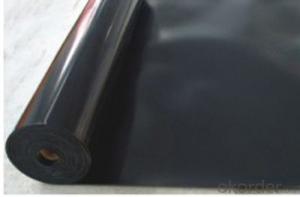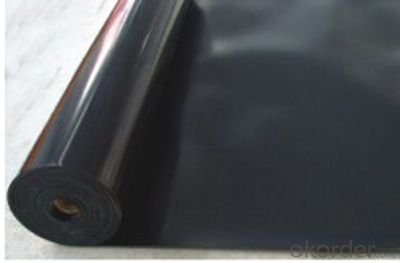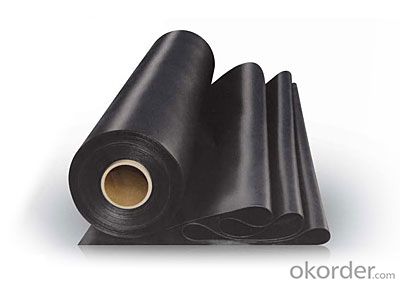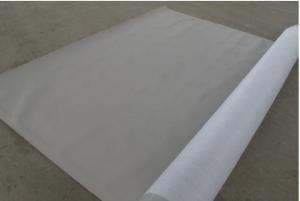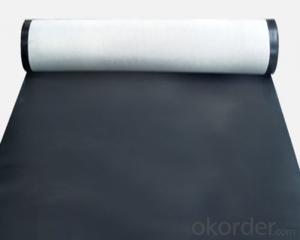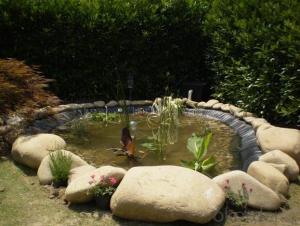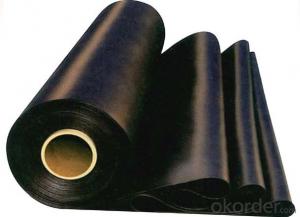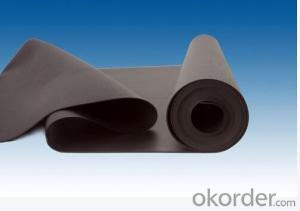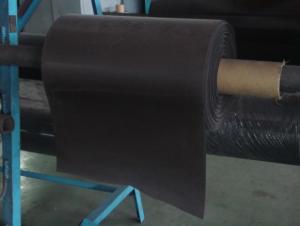Epdm Rubber Waterproofing Membrane for Roof
- Loading Port:
- China main port
- Payment Terms:
- TT OR LC
- Min Order Qty:
- 5000 m²
- Supply Capability:
- 100000 m²/month
OKorder Service Pledge
OKorder Financial Service
You Might Also Like
1.Structure of Epdm Rubber Waterproofing Membrane Description:
Epdm waterproofing materials is a new kind of high polymer waterproof material, using the du pont production,excellent aging resistance of epdm rubber, as main material.It has excellent quality.The product has excellent physical and mechanical properties, high breaking,high elongation rate, high tear strength, ageing resistance, ozone resistance, cold resistance and low water absorbability, stable quality, reliable. Various technical indexes reach or exceed the index set by the state.It's suitable for all kinds of waterproof and overlying protective layer of roofing, basement, reservoir, toilet rooms, tunnel, subway, bridges, DAMS and other waterproof engineering.
2.Atention:
• When it comes across rain, snow, fog, strong wind ,it cannot be coil construction.
• Coil adhesive volatile.When construction, it should be along with it into a container. Packaging barrels should be closed in time, and binder should be shaked when using rear can be used.
• When it's in construction ,it should be far away from fire and heat source.
3.Main Features of Epdm Rubber Waterproofing Membrane:
•Excellent anti-aging performance, chemical corrosion resistance, it can be applied to special occasions, the service life of is up to 50 years.
•High elongation and higher tensile strength ,small heat treatment size changing ;
•Special molecular structure of modified, it is effectively to solve the shortage problems of adhesive lap;
•Good flexibility in low tempreture, adapting to the environment temperature changes;
•Construction is convenient, lap joint is firm and reliable, and no environment pollution.
4.Epdm Rubber Waterproofing Membrane Specification:
| thickness | 1.2 | 1.5 | 2.0 | |
| width | 1.0 | 1.2 | 20 | |
| lenth | 20 | |||
| area | 20 | 24 | ||
5.Epdm Rubber Waterproofing Membrane Imges:
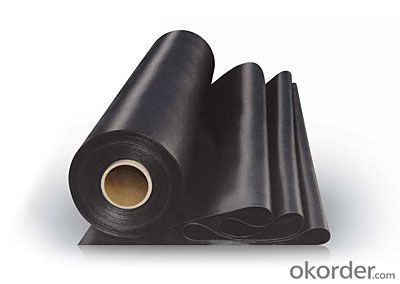
- Q: Does a waterproofing membrane require any special cleaning or maintenance procedures?
- Yes, a waterproofing membrane does require special cleaning and maintenance procedures. While it is designed to be resistant to water and other elements, regular maintenance is important to ensure its longevity and effectiveness. The specific cleaning and maintenance procedures may vary depending on the type of waterproofing membrane used, but generally, it is recommended to keep the membrane clean and free from debris, such as leaves, dirt, or other foreign objects. This can be done by regularly sweeping or gently washing the surface with water and a mild detergent if necessary. Additionally, it is important to inspect the membrane regularly for any signs of damage, such as tears, cracks, or loose seams. Any such issues should be addressed promptly to prevent water infiltration and further damage. In some cases, specialized cleaning products or treatments may be recommended by the manufacturer or installer of the waterproofing membrane. It is important to follow their guidelines and recommendations to ensure the best care and maintenance for the specific membrane used. Overall, regular cleaning and maintenance of a waterproofing membrane will help to extend its lifespan and ensure its continued effectiveness in protecting the underlying structure from water damage.
- Q: Can a waterproofing membrane be used for a hotel?
- Yes, a waterproofing membrane can be used for a hotel. Waterproofing membranes are commonly used in construction projects, including hotels, to prevent water intrusion and protect the building structure from damage. These membranes can be applied to various areas such as roofs, basements, bathrooms, and swimming pools to ensure the hotel remains dry and free from water-related issues.
- Q: Can waterproofing membranes be used on concrete pools?
- Yes, waterproofing membranes can be used on concrete pools. Waterproofing membranes are designed to provide a barrier against water penetration and can be applied to various surfaces, including concrete. Concrete pools are susceptible to water leakage over time due to cracks or deterioration, and applying a waterproofing membrane can help prevent these issues. The membrane is typically applied to the pool's interior surface, creating a seamless and watertight seal. It is important to choose a high-quality waterproofing membrane specifically designed for use in swimming pools to ensure long-lasting and effective results.
- Q: How does a waterproofing membrane withstand temperature changes?
- A waterproofing membrane is designed to withstand temperature changes due to its material composition and structural properties. The membrane is typically made of a flexible and durable material, such as modified bitumen, EPDM (ethylene propylene diene monomer), PVC (polyvinyl chloride), or TPO (thermoplastic olefin). These materials have inherent properties that allow them to expand and contract with temperature variations, ensuring the membrane remains intact and effective. The membrane's flexibility is crucial in accommodating temperature changes. When exposed to heat, the membrane expands to prevent cracking or splitting. Conversely, in colder temperatures, the membrane contracts to maintain its integrity and prevent any gaps from forming. This flexibility also helps to absorb any movement or stress caused by thermal expansion and contraction, preventing damage to the waterproofing system. Additionally, the membrane's composition often includes additives that enhance its resistance to temperature changes. These additives can include UV stabilizers, which protect the membrane from the damaging effects of sunlight, and thermal stabilizers, which help to maintain the membrane's integrity and performance in extreme temperatures. Furthermore, the installation techniques used for waterproofing membranes also play a vital role in their ability to withstand temperature changes. Proper installation methods, such as allowing for sufficient overlap and securely sealing all joints and seams, help to create a continuous and robust barrier against water infiltration. This ensures that the membrane remains effective even when subjected to temperature fluctuations. Overall, a waterproofing membrane is specifically engineered to withstand temperature changes by utilizing flexible and durable materials, incorporating additives to enhance its resistance, and employing proper installation techniques. These factors allow the membrane to adapt to varying temperature conditions, maintaining its integrity and providing long-lasting protection against water intrusion.
- Q: Can a waterproofing membrane be used on tunnels with fire protection systems?
- Tunnels equipped with fire protection systems can indeed make use of a waterproofing membrane. It is actually quite common to recommend the use of a waterproofing membrane alongside fire protection systems in tunnels, as it adds an extra layer of safeguarding. The purpose of this membrane is to prevent any water from infiltrating the tunnel, as this could potentially harm the fire protection systems and undermine their effectiveness. By ensuring the tunnel remains watertight, the waterproofing membrane preserves the integrity and functionality of the fire protection systems, enabling them to fulfill their intended purpose in the event of a fire. Moreover, the waterproofing membrane can also serve as a barrier, impeding the spread of fire by blocking the passage of flames and smoke. Nonetheless, it is crucial to ensure that the chosen waterproofing membrane is compatible with the specific fire protection systems employed in the tunnel in order to ensure optimum performance and safety.
- Q: Can a waterproofing membrane be used in areas with chemical exposure, such as industrial settings?
- In industrial settings, a waterproofing membrane can indeed be utilized even in areas where chemical exposure is a concern. However, it is vital to carefully consider the compatibility of the chosen waterproofing membrane with the chemicals that are present. Different membranes possess varying degrees of resistance to different chemicals, hence the utmost importance of selecting a membrane that can endure the specific chemical exposure in the industrial setting. Furthermore, ensuring the proper installation and maintenance of the waterproofing membrane is crucial in order to guarantee its effectiveness and longevity in such environments. Regular inspections must be carried out, and any damage caused by chemical exposure should be promptly addressed through repairs or replacements. Ultimately, by making the right choice and consistently maintaining it, a waterproofing membrane can serve as an effective barrier against water and chemicals in industrial settings.
- Q: Can a waterproofing membrane be used for a school building foundation?
- A school building foundation can indeed utilize a waterproofing membrane. These membranes are specifically created to safeguard structures by preventing water from infiltrating. They are commonly employed in various construction scenarios, including building foundations. By applying a waterproofing membrane to the foundation walls, it can effectively shield the building from water-related harm and prevent issues caused by moisture, such as mold, decay, and structural damage. This is especially crucial for school buildings due to their extensive foundations and the possibility of heavy usage and water exposure. Thus, the use of a waterproofing membrane is a viable solution to ensure the durability and structural soundness of the school building foundation.
- Q: Can a waterproofing membrane be used for a swimming pool?
- Indeed, a swimming pool can benefit from the utilization of a waterproofing membrane. In the realm of construction, waterproofing membranes find frequent application in order to avert water infiltration and leakage. Once administered to both the walls and floor of a swimming pool, a waterproofing membrane establishes a protective barrier that thwarts the infiltration of water into the adjacent structures. This essential measure is imperative for upholding the pool's integrity and averting harm to the surrounding regions. Tailored specifically for swimming pools, waterproofing membranes are engineered to endure the perpetual exposure to water and chemicals, guaranteeing durable safeguarding.
- Q: Can a waterproofing membrane be used on precast plaster surfaces?
- Yes, a waterproofing membrane can be used on precast plaster surfaces. These membranes are designed to provide a protective barrier against moisture, preventing water penetration and potential damage to the plaster surface.
- Q: Can a waterproofing membrane be used on vinyl surfaces?
- Indeed, one can employ a waterproofing membrane on vinyl surfaces. Vinyl surfaces, including vinyl flooring or vinyl siding, are frequently encountered in both residential and commercial structures. Waterproofing membranes are specifically crafted to establish a barrier against water and moisture, effectively hindering their infiltration into the underlying materials. By applying such membranes onto vinyl surfaces, an extra layer of safeguarding is provided, thereby guaranteeing that the vinyl remains unharmed by water-related issues or decay. Selecting a waterproofing membrane that is compatible with vinyl surfaces is crucial, as is adhering to the manufacturer's instructions for correct application.
Send your message to us
Epdm Rubber Waterproofing Membrane for Roof
- Loading Port:
- China main port
- Payment Terms:
- TT OR LC
- Min Order Qty:
- 5000 m²
- Supply Capability:
- 100000 m²/month
OKorder Service Pledge
OKorder Financial Service
Similar products
Hot products
Hot Searches
Related keywords
